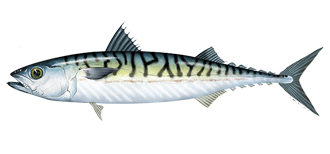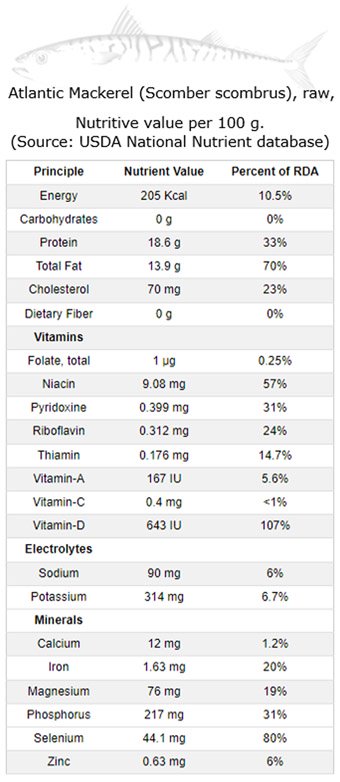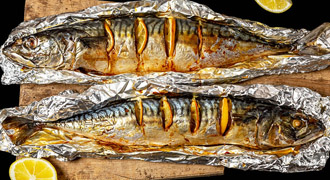Atlantic Mackerel Nutrition facts
The Atlantic mackerel is a highly popular saltwater fish, renowned for its rich and oily flesh. This small, pelagic fish is found in the temperate waters of the northern Atlantic Ocean, where it is extremely common and occurs in huge shoals in the epipelagic zone.
Atlantic mackerel is a fast-swimming fish in the Scombridae family and its scientific name is Scomber scombrus. Other common names are Common mackerel, Boston mackerel, and Caballa.
 |
| Atlantic Mackerel (Scomber scombrus). Photo: NOAA Fisheries. |
Appearance: The Atlantic mackerel, known for its streamlined body and swift swimming abilities, exhibits a striking blend of colors. Its body features iridescent blue-green tones along the upper side, and silvery white underbelly.
The mackerel's upper body presents around 15 to 20 undulating dark bars, a slim dark streak that runs below these bars along each side. It possesses two large dorsal fins and deeply forked tail fins shaded in gray or dusky tones, while the pectoral fins stand out with their black and dusky coloring.
The scales are small and the skin feels velvety. Atlantic mackerel, unlike many of their relatives, do not have a swim bladder.
Habitat: Atlantic mackerel inhabit both sides of the North Atlantic Ocean in cold and temperate waters over the continental shelf. They swim in schools near the surface and travel to and from spawning and summering grounds.
In the U.S. western Atlantic, they are found from Labrador down to North Carolina.
Biology: Atlantic mackerel grow fast, up to 16 ½ inches and 2.2 pounds. They can live up to 20 years and are able to reproduce by the time they reach age 2 to 3. They primarily spawn from April to May, 10 to 30 miles off shore.
Depending on their size, females release their eggs in batches, between five and seven times throughout the spawning season.
Atlantic mackerel feed primarily on crustaceans such as copepods, krill, shrimp and small fish.
Health benefits of Atlantic Mackerel
Atlantic mackerel are oily marine fish. Each serving of 100 g (3.5 oz) holds 205 calories. Its fatty flesh is a rich source of long-chain omega-3 fatty acids, fat-soluble vitamins, protein, and minerals.
Atlantic mackerel compose good quality protein. 100 g servings of fresh fish hold 18.6 g (33% of DRI) of easily digestible protein that is complete in all essential amino acids.
Being a fatty fish, Atlantic mackerel holds more than 50% fat; particularly long-chain fatty acids and omega-3s like eicosapentaenoic acid (EPA) and docosahexaenoic acid (DHA). Research studies suggest that these fatty acids, particularly DHA, play a major function as the building block of our neural system, and therefore particularly important for optimal brain and neurodevelopment in infants and children.
In adults, regular consumption of two servings per week of oily fish has been found to have a beneficial effect on the heart. In the "GISSI Prevention Trial, heart attack survivors who took a 1-gram capsule of omega-3 fats every day for three years were less likely to have a repeat heart attack, stroke, or die of sudden death than those who took a placebo".
Also, Atlantic mackerel are a good source of vitamins A, E, and D. 100 g of flesh contains 167 IU of vitamin A. Together with omega 3's, vitamin A is essential for healthy mucosa and skin.
100 g servings hold 643 IU of vitamin-D; about 107% of daily recommended intake. Vitamin D plays an important role in calcium metabolism and offers protection from cancers.
Atlantic mackerel has the lowest methyl-mercury content (0.050 PPM/100 g) among mackerel (Scombridae) family fish. Food and Drug Administration (FDA) recommends that pregnant women eat at least 8 ounces and up to 12 ounces (340 grams) of a variety of seafood low in mercury a week.
Additionally, they are exceptionally good sources of bone minerals including calcium, phosphorus, and magnesium. The other trace elements found abundantly found in this fish are selenium and iodine.

|
Buying
According to NOAA fisheries, the U.S. commercial fishery for Atlantic mackerel operates primarily between January and May in southern New England and Mid-Atlantic coastal waters and between May and December in the Gulf of Maine. This enables a continuous supply of freshly caught seafood year-round.
In the shops, Atlantic mackerel is sold fresh, frozen, in fillets, headed and gutted, and as steaks. You can also find smoked, or salted whole in specialty stores.
If you're in search of fresh mackerel, look for bright, firm fish with clean skin, pink gills, and clear eyes.
Storage
Due to its high oil content, mackerel spoil quickly unless they are chilled immediately after catching. Those intended for freezing should be promptly chilled after being caught and frozen within a 12-hour window. When properly stored at -30°C in cold storage, frozen mackerel will maintain good quality for a minimum of 6 months.
Proper handling of mackerel is essential to avoid an increased risk of scombroid poisoning if there is a lack of ice or refrigeration.
Preparation
Atlantic mackerel are delicate fish that should be handled properly by keeping them well-iced kept at the lowest possible temperature from the moment of capture until consumption.
Its flesh is soft, flaky, and moist and has a high oil content, and a has a rich, pronounced flavor and fishy taste. It is an excellent substitution for other fish with high oil content such as salmon, tuna, or bluefish.
Because of its high-fat content, mackerel is suitable for grilling, but many recipes call for it to be pan-fried, baked, or broiled. Mackerel complements well with acidic flavorings such as tomato.
Here are some serving ideas:
 |
| Baked mackerel with lemon slices in foil. Photo credit: Marco Verch |
Grilled mackerel with lemon and garlic is a delicious recipe.
Enjoy flavorful Italian-style smoked mackerel puttanesca pasta.
Prepare mouthwatering mackerel patties with canned mackerel, bread crumbs, parmesan, and spices.
Safety profile
Scombroid fish poisoning, also known as histamine fish poisoning, is an allergic-type reaction that occurs after consumption of certain improperly refrigerated fish such as tuna, mackerel, amberjack, and bonito. Since histamines are heat-resistant, cooking spoiled fish will not make it safe to eat.
The most common symptoms are rash, diarrhea, reddening of the face and sometimes the neck, arms, and upper part of the body, sweating, headache, palpitations, and vomiting. Urgent medical attention is needed in severe cases.
The methyl-mercury content of fresh/frozen mackerel is 0.050 PPM, and hence, categorized as the "Best Choice" fish. FDA advises that one can eat 2 to 3 servings a week from the "Best Choice" list (adult 1 serving = 4 ounces). To compare, King mackerel has 0.73 ppm; categorizing it in the list- "avoid".
Also read ≺≺-
≺≺- Mercury in Fish: Health Benefits, Risks, and Safe Choices
≻≻-Sardines nutrition facts and health benefits.
≻≻-Atlantic cod nutrition facts and health benefits.
≻≻- Trout fish nutrition facts and health benefits.
≻≻- Dover sole nutrition facts and health benefits.
≻≻- Back to Seafood from Atlantic Mackerel nutrition facts and health advantages.
Further reading (Links opens in new window):
NOAA-Fisheries -Scomber scombrus.
Omega-3 Fatty Acids: An Essential Contribution.
Scombroid fish poisoning: California Department of Public Health.